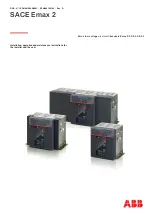
Effective 8/13/99
Page 10
I.L. 70C1037H02
rating specified on the plug label. The current sensor
rating can be viewed through openings in the back of the
breaker.
2.5 Current Sensors (Magnum Frames greater than 3200A)
The six (3-pole) or eight (4-pole) current sensors installed
in the circuit breaker are located on the lower conductors.
The poles are paralleled and the corresponding current
sensors are also paralleled (see Figure 2.3). For ex-
ample, a 4000A breaker phase rating has two 2000:1
current sensors wired in parallel, which provides an
overall ratio of 4000:2. The auxiliary current transformers
have a ratio of 20:1 for this size breaker which further
steps down the rated current to 100 milliamperes and is
equivalent to 100% (
In) to the Digitrip.
3.0 PRINCIPLES OF OPERATION
3.1 General
The Digitrip DT20 family of trip units is designed for
industrial circuit breaker environments where the ambient
temperatures can range from –20
°
C to +85
°
C but rarely
exceed 70
°
to 75
°
C. If, however, temperatures in the
neighborhood of the trip unit exceed this range, the trip
unit performance may be degraded. In order to insure that
the tripping function is not compromised due to an over-
temperature condition, the Digitrip 520 family microcom-
puter chip has a built-in over-temperature protection
feature, factory set to trip the breaker if the chip tempera-
ture is excessive. On the 520 family, if over-temperature
is the reason for the trip the red Long Delay Time LED will
flash.
The Digitrip uses the Cutler-Hammer custom-designed
S
µ
RE+chip™, an integrated circuit that includes a
microcomputer to perform its numeric and logic functions.
The principles of operation of the trip unit are shown in
Figure 3.1.
In the Digitrip DT20 family of trip units, all sensing and
tripping power required to operate the protection function
is derived from the current sensors in the circuit breaker.
The secondary currents from these sensors provide the
correct input information for the protection functions, as
well as tripping power, whenever the circuit breaker is
carrying current. These current signals develop analog
voltages across the current viewing resistors. The result-
ing analog voltages are digitized by the S
µ
RE+chip™.
The microcomputer continually digitizes these signals.
This data is used to calculate true RMS current values,
which are then continually compared with the protection
function settings and other operating data stored in the
Table 2.2 Ground (Earth) Fault Current Settings
Ground Fault Current Settings
(Amperes)
1
Installed
Sensor/
Rating Plug
(Amperes) In
.25
.30
.35
.40
.50
.60
.75
1.0
200
50
60
70
80
100
120
150
200
250
63
75
88
100
125
150
188
250
300
75
90
105
120
150
180
225
300
400
100
120
140
160
200
240
300
400
600
150
180
210
240
300
360
450
600
630
158
189
221
252
315
378
473
630
800
200
240
280
320
400
480
600
800
1000
250
300
350
400
500
600
750
1000
1200
300
360
420
480
600
720
900
1200
1250
312
375
438
500
625
750
938
1250
1600
400
480
560
640
800
960
1200 1600
2
2000
500
600
700
800
1000
1200
1500
2
2000
2
2500
625
750
875
1000
1250
1500
1875
2500
3000
750
900
1050
1200
1500
2
1800
2
2250
2
3000
2
3200
800
960
1120
1200
1600
2
1920
2
2400
2
3200
2
4000
3
1000
1200
1400
2
1600
2
2000
2
2400
2
3000
2
4000
2
5000
3
1250
2
1500
2
1750
2
2000
2
2500
2
3000
2
3750
2
5000
2
6300
3
1575
1890
2205
2520
3150
3780
4725
6300
1. Tolerance on settings are ±10% of values shown.
2. On Models 520 LSIG and 520M LSIG, the shaded values are set to a maximum
trip value of 1200 amperes for NEC.
3. See Section 2.5.
2.4 Current Sensors (Magnum Frames less than or equal to
3200A)
The three (3-pole) or four (4-pole) primary current sensors
are installed internally in the circuit breaker on the lower
conductors of the breaker. The current sensor rating
defines the breaker rating (
In). For example, 2000A:1A
sensors are used on a 2000A rated breaker. There are
four auxiliary current transformers with a ratio of 10:1
which further step down the rated current to 100 milliam-
peres, which is equivalent to 100% (
In) to the Digitrip.
The primary current sensors produce an output propor-
tional to the load current and furnish the Digitrip DT20
family with the information and energy required to trip the
circuit breaker when functional protection settings are
exceeded.
If a set of current sensors with a different ratio are in-
stalled in the field, the rating plug must also be changed.
The associated rating plug must match the current sensor

































